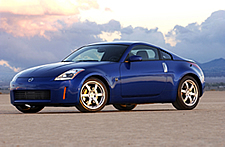 A
A few years ago, when Nissan unveiled its Revival Plan, many
skeptics questioned whether the company could regain the stronghold
in the marketplace it enjoyed for so many years. The excitement
had all but disappeared for this Japanese manufacturer with
the retirement of the 300ZX in 1996. All other Nissan models
were growing old gracefully, as were its buyers. Nissan President
and CEO Carlos Ghosn, who spearheaded "The Plan,"
said that one of the ways he intended to revitalize the company
was with great products; and after just a few years and a handful
of outstanding new vehicles, we now know he meant it. A
A few years ago, when Nissan unveiled its Revival Plan, many
skeptics questioned whether the company could regain the stronghold
in the marketplace it enjoyed for so many years. The excitement
had all but disappeared for this Japanese manufacturer with
the retirement of the 300ZX in 1996. All other Nissan models
were growing old gracefully, as were its buyers. Nissan President
and CEO Carlos Ghosn, who spearheaded "The Plan,"
said that one of the ways he intended to revitalize the company
was with great products; and after just a few years and a handful
of outstanding new vehicles, we now know he meant it.
Nissan's
well on its way to being a major player again, and not just in the sports car
arena. It currently has a popular SUV with the Xterra, an award-winning Altima
sedan, an enticing entry-level Sentra, and a supercharged Frontier pickup, with
a full-size truck looming on the horizon. But Nissan was smart enough to know
that the cache of the Z badge could not be ignored. With the 2003 model year,
the Z steps forward to the head of the lineup, and rightfully takes its place
as a brand image leader for this phoenix automotive company. The
350Z has all the features necessary to please those in the market for a fun-to-drive
sports coupe. The best news is no one will have to cash in a 401K plan to buy
it, either.
The
importance of the Z to Nissan cannot be overstated. The original Datsun 240Z first
sold in the States in 1969 as a 1970 model. The Z shape was a departure from sports
cars of the day, and its powerful 150-horsepower 2.4-liter six-cylinder engine
and reasonable base price of $3,526 made it a favorite of just about anyone looking
to add excitement to his or her life. To date, over one million Datsun/Nissan
Zs have been sold here, making it the all-time best-selling sports car. Quite
the feat for Nissan in the land of Porsches and Bimmers.
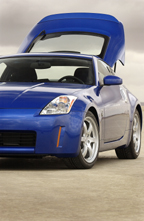 The
new 350Z began life in 1998, and had to meet three requirements:
it had to be a true 2-seater, offer a hatchback body design
and be rear-wheel-driven. In essence, it was supposed to "embody
the spirit of the original 240Z, updated, with performance and
value." This is from the Z's guiding statement, and the team stuck close to its mission. The
new 350Z began life in 1998, and had to meet three requirements:
it had to be a true 2-seater, offer a hatchback body design
and be rear-wheel-driven. In essence, it was supposed to "embody
the spirit of the original 240Z, updated, with performance and
value." This is from the Z's guiding statement, and the team stuck close to its mission.
After
showing off a few concept models at various auto shows and gauging public reaction,
Nissan finalized the design, which incorporates an even blend of heritage lines
with 21st-century styling. The result is a clean, contemporary, well-balanced
appearance. The new Z is based on the FM platform, which also serves as the underpinnings
for the Infiniti G35 sedan and coupe, as well as being the basis for other vehicles
to come from Nissan. The platform allows for a long wheelbase, wide track, and
fully independent suspension setup, which is exactly what the new sports car needed.
The
Z's exterior treatment features short front and rear overhangs, wheelwell bulges,
and a body that flows smoothly like hot fudge over ice cream. The designers
did a good job of mixing modernl shapes with softer, rounded
edges. If done wrong, designs like these can be a disaster (see Pontiac Aztek).
With talented designers on the Z team from Europe, Japan, and California, the
results are stunning instead of stupefying.
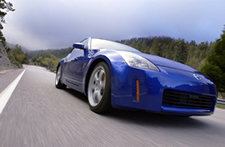 Some of the design elements include eye-catching front projector-type flush-mounted halogen headlights that are a modified trapezoidal shape, and they provide an identifying face for the new Z. A recurrent theme is the three-box pattern found on the wheels and door handles, and although they were originally designed to light up at night (but do not because of budget restraints), don't really signify anything except to bring in a post-modern design element. Some of the design elements include eye-catching front projector-type flush-mounted halogen headlights that are a modified trapezoidal shape, and they provide an identifying face for the new Z. A recurrent theme is the three-box pattern found on the wheels and door handles, and although they were originally designed to light up at night (but do not because of budget restraints), don't really signify anything except to bring in a post-modern design element.
A defined beltline and long hood and shorter aft proportions makes the "Z-ness" of the original is more apparent. The vertical door handles and twin exhaust pipes are two more examples of how the designers wanted to pair together both the image of contemporary design with performance.
According to Mamoru Aoki, product chief designer of the Nissan Technical Center in Japan, Nissan wanted the Z to express agility. "The Z is fluid and relaxed, from the curve of the door cut to the freeness and movement of the glass. It looks fast, but not just in a straight line. It's a simple yet exacting design, which gives the Z a polished feeling."
The Nissan 350Z is not a vehicle that could ever be mistaken for anything else. To fill the wheelwells and finish the package are standard 225/50R17 front and 235/50R17 rear tires mounted on 17x7.5-inch aluminum wheels.
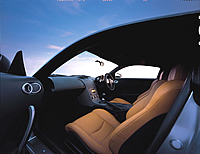 The same design elements are carried over to the interior, along with a feeling of quality. A true 2-seater, the Z offers decent room for the driver and passenger. There's little intrusion on the other's space, and even with the set-back windshield you don't feel cramped and caged as you do in other small sports cars. The seats are unusual in that they are designed differently for the driver and passenger; the right side bolster for the driver is cut back so it doesn't interfere with shifting maneuvers and the seat is a bit more supportive for spirited driving, while the passenger's seat is set up more for comfort. The same design elements are carried over to the interior, along with a feeling of quality. A true 2-seater, the Z offers decent room for the driver and passenger. There's little intrusion on the other's space, and even with the set-back windshield you don't feel cramped and caged as you do in other small sports cars. The seats are unusual in that they are designed differently for the driver and passenger; the right side bolster for the driver is cut back so it doesn't interfere with shifting maneuvers and the seat is a bit more supportive for spirited driving, while the passenger's seat is set up more for comfort.
The gauges are in a three-pod design that move with the steering wheel so they are always in view, which is a major plus since so many other vehicles provide movement of the steering wheel only, which usually blocks the speedo or tach numbers. The steering wheel is a three-spoke design, and feels good to the touch. The center stack features three more gauges canted toward the driver, along with the HVAC and audio controls, and a space for the optional navigation system.
The passenger side is a lot less interesting since there are no instruments, and even the glovebox has been relocated to behind the seat to allow room for the airbag, but is large enough to hold a decent-size purse. Ergonomics are good; parts fit well in the hand and everything is within reach. The mandatory cupholders are small and will work in a pinch, but this is one of the few vehicles in which they're unnecessary; you should be spending more time shifting than sipping.
Aluminum is used throughout the cabin as accent pieces on door handles, pedals and trim items, and help to highlight the interior's overall clean, contemporary appearance. The Z's interior complements the exterior design, and it's obvious as much thought was applied to the inside as well as the outside, which, again, in many other vehicles doesn't happen all the time. This is one of Nissan's strongest design elements across its car/truck lineup: its designers understand that it's equally important to create an interior as visually appealing as the exterior.
Providing a comfortable, inviting interior is important, since you'll be spending a lot of time behind the wheel once you've taken a spin in the new 350Z. Fun to drive isn't just a concept in the new Z; it's a reality. Under the hood is a 3.5-liter DOHC 24-valve V-6 good for 287 hp @ 6,200 rpm and 274 lb-ft of torque at 4,800 rpm. With the near-perfect 53/47 percent front/rear weight distribution, the Z understands the zen of balance at speed. From the outstanding VQ-series engine to the standard six-speed close-ratio transmission is an impressive transfer of power, as the Z takes corners and straightaways with the sticking ability of fresh gum on the bottom of new shoes.
The engine was massaged to generate the impressive horsepower and torque figures for this 3,188-lb coupe, and features a variety of tuning tricks such as increasing valve lift, reducing exhaust system backpressure, and bumping the compression ratio to 10.3:1 to help with low-end torque for a faster off-the-line punch. The 3.5-liter also utilizes an aluminum block and heads, lighter pistons and connecting rods, and lightweight, hollow camshafts, all of which contribute to reduced weight and improved fuel economy and performance.
In addition, the new Z features drive-by-wire technology, where there's no mechanical connection from the accelerator pedal to the engine. It's all controlled via the Engine Control Module (ECM), which then processes the request and, if all other systems agree (i.e., traction control and transmission), delivers the power instantaneously.
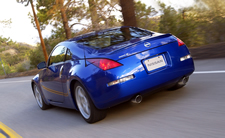 Balancing a sports car to provide equally good ride and handling characteristics is one of the toughest jobs for engineers. Too stiff a ride and buyers might cross it off the list; too soft in the turns and enthusiasts will look elsewhere for their fun. That's why Nissan engineers went with a new front suspension designed to deliver nimble response along with an impressive highway ride. This was achieved via a multi-link arrangement with upper and lower wishbone links, except that the lower link has been divided in order to optimize the wheel alignment whether the Z is turning or traveling straight. This new suspension setup is so unique that Nissan has already been awarded 14 patents for design and execution. In back, the rear suspension helps deliver a "flat ride," as Nissan calls it, which provides less lateral movement and higher stability. It also offers more compliance up and down to help create a pleasant highway feel. Balancing a sports car to provide equally good ride and handling characteristics is one of the toughest jobs for engineers. Too stiff a ride and buyers might cross it off the list; too soft in the turns and enthusiasts will look elsewhere for their fun. That's why Nissan engineers went with a new front suspension designed to deliver nimble response along with an impressive highway ride. This was achieved via a multi-link arrangement with upper and lower wishbone links, except that the lower link has been divided in order to optimize the wheel alignment whether the Z is turning or traveling straight. This new suspension setup is so unique that Nissan has already been awarded 14 patents for design and execution. In back, the rear suspension helps deliver a "flat ride," as Nissan calls it, which provides less lateral movement and higher stability. It also offers more compliance up and down to help create a pleasant highway feel.
Another area of importance are the brakes and braking/traction systems, since sports cars are not only about going fast and turning well, but also about stopping quickly under pressure. To that end, Nissan has employed a power-assisted four-wheel-disc ABS setup with large front and rear rotors and calipers. In addition, Electronic Brake force Distribution and Brake Assist come standard, both of which are designed to help in balancing braking effort as well as improve stopping distances under emergency braking situations. In addition to the state-of-the-art braking systems, the new Z also offers optional traction control and its Vehicle Dynamic Control stability program that help keep the Z under control in oversteer/understeer situations such as inclement weather or hard driving cornering situations.
With the combination of a powerful engine, new suspension and a dynamic chassis, the 350Z handles every road with grace and ease. Moving the 350Z around the corners initiates little drama. The ride is stiff enough to feel the bumps when taking serious S-curves back to back at speed, but smoothes out nicely on the highway for a less-emphatic cruising attitude.
Because the platform is so solid, the engineers had no trouble dialing in such a precise suspension. The responsive, engine-speed-sensitive rack-and-pinion power steering is linear, on center, and on par with much more expensive sports cars. The big 17-inch standard rubber does an excellent job of providing grip, and after a few hours of hard diving into corners, we found it impossible to get the tires to lose traction. As far as the six-speed tranny goes, the shifts are short, smooth, and precise; it's like the Mary Poppins of shifters: practically perfect in every way. About the only negative we could conjure up is that the C-pillar provides a fairly decent blind spot, but that's a small price to pay for such a high level of driving enjoyment.
Don't think that Nissan's only concern were enthusiasts with a hardcore desire to always take the mountain route to work. There are six different versions of the Z, with a little something for every taste. If you're looking for styling along with day-to-day usage at an affordable price, opt for the Base model, which comes with plenty of standard features such as an AM/FM/CD sound system, power windows/locks/mirrors, remote keyless entry, automatic climate control and the six-speed manual tranny. It goes for $26,269.
If you're going for a step up from there, choose from either Enthusiast model, with either the six-speed MT or a five-speed automatic with manual mode(clutchless shifting). That also includes a limited-slip differential, aluminum pedals, HomeLink, and Xenon headlamps for $28,219 ($28,249 with 6MT). The next step is for those looking for a bit more on the Performance model, which nets you VDC, tire pressure monitor system, 18-inch wheels and tires, TCS, a limited-slip diff, and other goodies for $29,429. The next two are Touring models, which deliver a higher level of interior amenities, including upgrade audio systems, power seats, heated goodies, and more for $30,429 to $31,589.
And saving the best for last is the Track model, which is set up for those who might want to venture into the competitive arena in autocrosses or track events. On this model you get a front and rear spoiler, lighter weight aluminum wheels, vented Brembo braking system, and some other performance goodies for $34,079. With so much going on in the model range, only two options exist: a DVD nav system;side airbag and side curtain airbags.
The Z goes on sale at the end of August, and Nissan's done a great job of generating excitement for its new "halo" vehicle. The goal for the team was to prove that the new 350Z could live up to its reputation, while at the same time comparing favorably to BMW's M Coupe and Porsche's Boxster, two vehicles with the same fun-to-drive quotient but at a much higher price. I think we can say unequivocally that the new heir to the Z throne will be more than able to fulfill its duties.
For more information on the 2003 Nissan 350Z, click here.
|